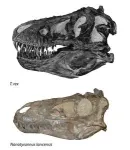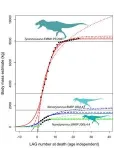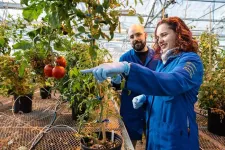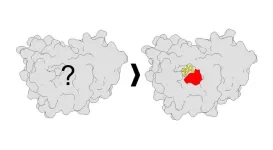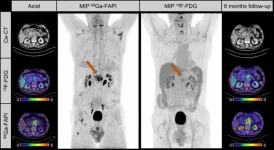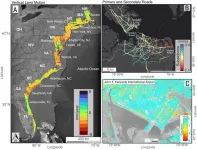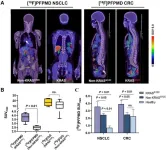(Press-News.org) In the quest to understand the potential for life beyond Earth, researchers are widening their search to encompass not only biological markers, but also technological ones. While astrobiologists have long recognized the importance of oxygen for life as we know it, oxygen could also be a key to unlocking advanced technology on a planetary scale.
In a new study published in Nature Astronomy, Adam Frank, the Helen F. and Fred H. Gowen Professor of Physics and Astronomy at the University of Rochester and the author of The Little Book of Aliens (Harper, 2023), and Amedeo Balbi, an associate professor of astronomy and astrophysics at the University of Roma Tor Vergata, Italy, outline the links between atmospheric oxygen and the potential rise of advanced technology on distant planets.
“We are ready to find signatures of life on alien worlds,” Frank says. “But how do the conditions on a planet tell us about the possibilities for intelligent, technology-producing life?”
“In our paper, we explore whether any atmospheric composition would be compatible with the presence of advanced technology,” Balbi says. “We found that the atmospheric requirements may be quite stringent.”
Igniting cosmic technospheres
Frank and Balbi posit that, beyond its necessity for respiration and metabolism in multicellular organisms, oxygen is crucial to developing fire—and fire is a hallmark of a technological civilization. They delve into the concept of “technospheres,” expansive realms of advanced technology that emit telltale signs—called “technosignatures”—of extraterrestrial intelligence.
On Earth, the development of technology demanded easy access to open-air combustion—the process at the heart of fire, in which something is burned by combining a fuel and an oxidant, usually oxygen. Whether it’s cooking, forging metals for structures, crafting materials for homes, or harnessing energy through burning fuels, combustion has been the driving force behind industrial societies.
Tracing back through Earth’s history, the researchers found that the controlled use of fire and the subsequent metallurgical advancements were only possible when oxygen levels in the atmosphere reached or exceeded 18 percent. This means that only planets with significant oxygen concentrations will be capable of developing advanced technospheres, and, therefore, leaving detectable technosignatures.
The oxygen bottleneck
The levels of oxygen required to biologically sustain complex life and intelligence are not as high as the levels necessary for technology, so while a species might be able to emerge in a world without oxygen, it will not be able to become a technological species, according to the researchers.
“You might be able to get biology—you might even be able to get intelligent creatures—in a world that doesn’t have oxygen,” Frank says, “but without a ready source of fire, you’re never going to develop higher technology because higher technology requires fuel and melting.”
Enter the “oxygen bottleneck,” a term coined by the researchers to describe the critical threshold that separates worlds capable of fostering technological civilizations from those that fall short. That is, oxygen levels are a bottleneck that impedes the emergence of advanced technology.
“The presence of high degrees of oxygen in the atmosphere is like a bottleneck you have to get through in order to have a technological species,” Frank says. “You can have everything else work out, but if you don’t have oxygen in the atmosphere, you’re not going to have a technological species.”
Targeting extraterrestrial hotspots
The research, which addresses a previously unexplored facet in the cosmic pursuit of intelligent life, underscores the need to prioritize planets with high oxygen levels when searching for extraterrestrial technosignatures.
“Targeting planets with high oxygen levels should be prioritized because the presence or absence of high oxygen levels in exoplanet atmospheres could be a major clue in finding potential technosignatures,” Frank says.
“The implications of discovering intelligent, technological life on another planet would be huge,” adds Balbi. “Therefore, we need to be extremely cautious in interpreting possible detections. Our study suggests that we should be skeptical of potential technosignatures from a planet with insufficient atmospheric oxygen.”
This work was funded in part by a grant from NASA.
END
Is oxygen the cosmic key to alien technology?
University of Rochester astrophysicist Adam Frank explores the links between atmospheric oxygen and detecting extraterrestrial technology on distant planets.
2024-01-02
ELSE PRESS RELEASES FROM THIS DATE:
How tomato plants use their roots to ration water during drought
2024-01-02
Plants have to be flexible to survive environmental changes, and the adaptive methods they deploy must often be as changeable as the shifts in climate and condition to which they adapt. To cope with drought, plant roots produce a water-repellent polymer called suberin that blocks water from flowing up towards the leaves, where it would quickly evaporate. Without suberin, the resulting water loss would be like leaving the tap running.
In some plants, suberin is produced by endodermal cells that line the vessels inside the roots. But in others, like tomatoes, suberin is produced in exodermal cells that sit just below ...
Targeted household cleaning can reduce toxic chemicals post-wildfire, Portland State research shows
2024-01-02
After the last embers of a campfire dim, the musky smell of smoke remains. Whiffs of that distinct smokey smell may serve as a pleasant reminder of the evening prior, but in the wake of a wildfire, that smell comes with ongoing health risks.
Wildfire smoke is certainly more pervasive than a small campfire, and the remnants can linger for days, weeks and months inside homes and businesses. New research from Portland State’s Elliott Gall, associate professor in Mechanical and Materials Engineering, examined how long harmful chemicals found in wildfire smoke can persist and the ...
New method illuminates druggable sites on proteins
2024-01-02
LA JOLLA, CA—Identifying new ways to target proteins involved in human diseases is a priority for many researchers around the world. However, discovering how to alter the function of these proteins can be difficult, especially in live cells. Now, scientists from Scripps Research have developed a new method to examine how proteins interact with drug-like small molecules in human cells—revealing critical information about how to potentially target them therapeutically.
The strategy, published in Nature Chemical Biology on January 2, 2024, uses a combination of chemistry and analytical techniques to reveal the specific places where proteins and small molecules bind ...
RSV vaccines would greatly reduce illness if implemented like flu shots
2024-01-02
Respiratory syncytial virus (RSV) vaccines recently approved for people 60 and older would dramatically reduce the disease’s significant burden of illness and death in the United States if they were widely adopted like annual influenza vaccines, a new study has found.
A high level of RSV vaccination would not only potentially reduce millions of dollars in annual outpatient and hospitalization costs but would also produce an economy of scale with individual shots being delivered at a relatively modest cost of between $117 and $245 per dose, the study said.
The vaccines are currently covered by most private insurers without ...
Ga-68 FAPI PET improves detection and staging of pancreatic cancer
2024-01-02
Reston, VA—PET imaging with 68Ga-FAPI can more effectively detect and stage pancreatic cancer as compared with 18F-FDG imaging or contrast-enhanced CT, according to new research published in the December issue of The Journal of Nuclear Medicine. In a head-to-head study, 68Ga-FAPI detected more pancreatic tumors on a per-lesion, per-patient, or per-region basis and led to major and minor changes to clinical management of patients. In addition to enhancing precise detection of pancreatic cancer, 68Ga-FAPI ...
Understanding climate mobilities: New study examines perspectives from South Florida practitioners
2024-01-02
Understanding Climate Mobilities: New study examines perspectives from South Florida practitioners
As climate change continues to impact people across South Florida, the need for adaptive responses becomes increasingly important.
A recent study led by researchers at the University of Miami Rosenstiel School of Marine, Atmospheric, and Earth Science, assessed the perspectives of 76 diverse South Florida climate adaptation professionals. The study titled, “Practitioner perspectives on climate mobilities in South Florida” was published in the December issue of the Journal Oxford Open Climate Change, and explores the expectations and concerns of practitioners from the ...
Study: From NYC to DC and beyond, cities on the East Coast are sinking
2024-01-02
Major cities on the U.S. Atlantic coast are sinking, in some cases as much as 5 millimeters per year – a decline at the ocean’s edge that well outpaces global sea level rise, confirms new research from Virginia Tech and the U.S. Geological Survey.
Particularly hard hit population centers such as New York City and Long Island, Baltimore, and Virginia Beach and Norfolk are seeing areas of rapid “subsidence,” or sinking land, alongside more slowly sinking or relatively stable ground, increasing the risk to roadways, runways, building foundations, rail ...
New PET tracer noninvasively identifies cancer gene mutation, allows for more precise diagnosis and therapy
2024-01-02
Reston, VA—A novel PET imaging tracer has been proven to safely and effectively detect a common cancer gene mutation that is an important molecular marker for tumor-targeted therapy. By identifying this mutation early, physicians can tailor treatment plans for patients to achieve the best results. This research was published in the December issue of The Journal of Nuclear Medicine.
Kirsten rat sarcoma (KRAS) is a commonly mutated oncogene that is present in approximately 20-70 percent of cancer cases. Patients with KRAS mutations usually respond poorly to standard therapies. As such, the National Comprehensive ...
Evolution might stop humans from solving climate change, says new study
2024-01-02
Central features of human evolution may stop our species from resolving global environmental problems like climate change, says a new study led by the University of Maine.
Humans have come to dominate the planet with tools and systems to exploit natural resources that were refined over thousands of years through the process of cultural adaptation to the environment. University of Maine evolutionary biologist Tim Waring wanted to know how this process of cultural adaptation to the environment might influence the goal of solving global environmental problems. ...
January issues of APA journals cover antidepressant outcomes, disparities in school-based support, civil commitment hearings, and more
2024-01-02
WASHINGTON, D.C., Jan 2, 2024 — The latest issues of three American Psychiatric Association journals, The American Journal of Psychiatry, Psychiatric Services and The American Journal of Psychotherapy are now available online.
The January issue of The American Journal of Psychiatry features studies focusing on improving clinical outcomes and informing new interventions. Highlights include:
Predicting Acute Changes in Suicidal Ideation and Planning: A Longitudinal Study of Symptom Mediators and the Role of the Menstrual ...
LAST 30 PRESS RELEASES:
Tracing the quick synthesis of an industrially important catalyst
New software sheds light on cancer’s hidden genetic networks
UT Health San Antonio awarded $3 million in CPRIT grants to bolster cancer research and prevention efforts in South Texas
Third symposium spotlights global challenge of new contaminants in China’s fight against pollution
From straw to soil harmony: International team reveals how biochar supercharges carbon-smart farming
Myeloma: How AI is redrawing the map of cancer care
Manhattan E. Charurat, Ph.D., MHS invested as the Homer and Martha Gudelsky Distinguished Professor in Medicine at the University of Maryland School of Medicine
Insilico Medicine’s Pharma.AI Q4 Winter Launch Recap: Revolutionizing drug discovery with cutting-edge AI innovations, accelerating the path to pharmaceutical superintelligence
Nanoplastics have diet-dependent impacts on digestive system health
Brain neuron death occurs throughout life and increases with age, a natural human protein drug may halt neuron death in Alzheimer’s disease
SPIE and CLP announce the recipients of the 2025 Advanced Photonics Young Innovator Award
Lessons from the Caldor Fire’s Christmas Valley ‘Miracle’
Ant societies rose by trading individual protection for collective power
Research reveals how ancient viral DNA shapes early embryonic development
A molecular gatekeeper that controls protein synthesis
New ‘cloaking device’ concept to shield sensitive tech from magnetic fields
Researchers show impact of mountain building and climate change on alpine biodiversity
Study models the transition from Neanderthals to modern humans in Europe
University of Phoenix College of Doctoral Studies releases white paper on AI-driven skilling to reduce burnout and restore worker autonomy
AIs fail at the game of visual “telephone”
The levers for a sustainable food system
Potential changes in US homelessness by ending federal support for housing first programs
Vulnerability of large language models to prompt injection when providing medical advice
Researchers develop new system for high-energy-density, long-life, multi-electron transfer bromine-based flow batteries
Ending federal support for housing first programs could increase U.S. homelessness by 5% in one year, new JAMA study finds
New research uncovers molecular ‘safety switch’ shielding cancers from immune attack
Bacteria resisting viral infection can still sink carbon to ocean floor
Younger biological age may increase depression risk in older women during COVID-19
Bharat Innovates 2026 National Basecamp Showcases India’s Most Promising Deep-Tech Ventures
Here’s what determines whether your income level rises or falls
[Press-News.org] Is oxygen the cosmic key to alien technology?University of Rochester astrophysicist Adam Frank explores the links between atmospheric oxygen and detecting extraterrestrial technology on distant planets.

